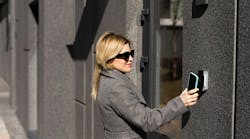It’s almost certain that the “hands-free” trend in electronic access control (EAC) will continue no matter whether COVID-19 continues much longer. This is particularly true with equipment manufacturers.
“I anticipate manufacturers will develop more solutions in the future, and, thus, there will be a continued opportunity for the locksmith industry to expand their services to aid in creating healthier buildings,” says Brad Sweet, commercial marketing leader at Allegion. “This includes a convergence of electronics with mechanical, which will introduce more opportunities for the industry to expand skills and related services.”
In addition, because smartphones have become so important to so many people, the development of mobile smartphone credentials is an absolute given.
“From the residential perspective, remote access and hands-free usage vis-a-vis electronic smart locks should grow exponentially in the locksmith industry,” says Erik Glassen, senior brand manager with Kwikset and Baldwin Hardware. “Even before the pandemic, there was a recognition within the industry that consumers enjoy and, in fact, demand remote access and touch-free usage based on convenience. What’s more, from a safety perspective, being able to check the status of your lock remotely through a smartphone or other web-enabled device is a major safety advantage. If someone isn't sure whether they locked their door, they can easily and quickly get the answer.”
Other manufacturers agree: Smartphone access, whether in conjunction with electronic locks or a full-scale EAC system, is huge and will continue to be in years to come.
“HID believes mobile credentials will deliver a more convenient, more efficient and more secure authentication experience,” says Steve Carney, vice president of product marketing, physical access control solutions with HID. “Thus, we continue to focus our R&D on mobile-credential technology as a whole to expand a platform and ecosystem that is independent of transport technology.”
The issue of using a smartphone as a personal ID credential isn’t new. Connect One has used mobile devices as a means of determining identity for some time. “First, we identify the person using their mobile device; then we identify the door through which they wish to enter by a barcode sticker,” Connect One Managing Partner Mike Simon says. “The time it takes to do this is just as fast as swiping a card.”
Locksmiths are positioned perfectly to take full advantage of the hands-free trend that the security market is immersed in. But the necessity for proper tools and skills is important, so after you begin to advertise this solution to the current COVID-19 crisis, you can back it up with products and the knowledge necessary to make it happen.
“There will always be a need for locksmiths, but for the industry to grow and locksmiths to be seen as the security professionals they are, they will need to adapt to a changing marketplace,” says Glen Davies, learning leader with dormakaba. “This includes going beyond the norms of working with mechanical hardware, electronic access control, alarms and video systems. It now includes low-energy operators, touch-free access devices and the electromechanical door hardware that works in conjunction with these systems.”
Government Regulations
The rise of the Novel Coronavirus in late 2019 triggered a law passed on a state-by-state basis in the early to mid-2000s. This legislation, the Model State Emergency Health Powers Act, called for a laundry list of precautions designed to assure that as few people as possible suffered the potential effects of a deadly infectious disease, such as COVID-19.
Social distancing, sheltering in place, masks, vaccinations and much more are the ultimate result of mandates set in motion by today’s health officials who, by virtue of the above legislation, are given enormous power over state governments. The direct result of all this has been the accelerated development of hands-free access.
“Since the early days of the pandemic, we’ve seen individuals opting for solutions that involve less hands-on operation to prevent the spread of germs,” Sweet says. “This has led many to seek out automatic hands-free solutions at both the exterior and interior doors.”
To fight the current pandemic, access control manufacturers have explored ways to minimize physical exposure to virus-laden surfaces, such as door handles, locks and other surfaces by otherwise healthy individuals. The result is a collection of hands-free products that locksmiths can put to use to assist clients during this difficult time.
As we look around the nation, we find a hodgepodge of rules and assumed regulations with regard to what businesses can and can’t do. Even when those who own these businesses do what they’re told, they’re still subject to a shutdown when health officials test and discover that an employee has or had COVID-19.
Obviously, it’s in the best interest of business owners to meet these challenges by using as many hands-free devices as possible. So, the first and most important part of this effort involves public entrances.
“In the summertime, people prop doors open so people don’t have to touch doors. So, it’s not a big deal in warm weather,” says Nick Markowitz, owner of Markowitz Electric & Integration of Verona, Pennsylvania. “But now that it’s wintertime, they don't want anyone to touch the doors. I’ve seen an increase in the amount of technology that making doors automatically open and the use of small buttons that cause a door to [automatically] open.”
Wireless/RFID Solutions
Today’s radio-frequency identification (RFID) technology provides larger distances between traditional credentials and readers compared with legacy technologies.
“We offer long-range readers that use UHF and RF technologies, which excel in our new touch-free world,” says Greg Peninger, regional sales manager central & west with Rosslare Security Products. “The readers and credentials can work up to 230 feet (RF) or 40 feet (UHF). As an added benefit, [they] come with Bluetooth technology built in standard. Our facial-recognition reader is a multifactor reader with up to four different credential technologies: facial, fingerprint, Bluetooth and RFID.”
HID’s Signo and Origo platforms also use the Open Supervised Device Protocol (OSDP) for more-secure bidirectional communications. OSDP, advanced and maintained by SIA (Security Industry Association), provides a high level of security by way of AES128 data encryption. According to HID, Signo includes support for the widest range of credential technologies, including HID Mobile Access via native Bluetooth and near field communication capability. Signo also features Apple’s Enhanced Contactless Polling to support credentials in the Apple Wallet. From a hands-free standpoint, this technology delivers a read range of 2–4 inches.
Other access card technologies provide a valuable means of hands-free access. Honeywell’s OmniClass uses 13.56-megahertz RFID technology, which provides a contactless read range of up to 4-1/2 inches. As with many card-oriented access credentials, the plastic card that drives this and many other hands-free access control products also can have pictures and text printed on them, thus providing a valid means of visually identifying a valid user when and where it’s necessary.
Remote Wireless EAC
Remote control of EAC, in conjunction with electronic locks, allows clients to control electric door locks from afar by using a mobile device. Alarm-system integration also is popular in smart-home and building automation applications.
By using a smartphone or tablet, it’s possible for a home or business owner to control the arm or disarm mode of an alarm system, turn lights on or off, adjust the temperature, view surveillance video and control the security of one or more doors.
“[Kwikset/Baldwin] began offering locks with remote access years ago, made possible by the introduction of our Home Connect technology, which allowed users to operate their locks remotely through any web-enabled device,” Glassen says. “So, honestly, we weren’t really heading in this direction, because we had already been there for quite some time.”
Another type of remote control is seen in ScanPass by Connect One. “Installation is as easy as putting a barcode sticker on a door,” Simon explains. “A smartphone reads the barcode to identify the door, and a unique credential in the phone is used to identify the individual. ScanPass is managed the same as a card or fob.”
Hands-Free Passage
Any of the hands-free EAC methods discussed in this article can be expanded to include an equally hands-free way of automatically opening and closing a door. Take, for example, the simple task of closing a door behind you. Although a standard door closer will close the door automatically, what about opening it?
“Prior to the onset of the pandemic, dormakaba already had a significant collection of touch-free solutions,” says Darren Blankenship, vice president of vertical sales with dormakaba. “With our deep portfolio of automatic operators, sliding doors, automatic revolving doors, touchless actuators, turnstile solutions and touch-free exit lanes, dormakaba was well-positioned to become a leader in healthy solutions.”
Allegion also offers a set of products designed to solve hands-free ingress and egress. It provides automatic operators, touchless actuators, mechanical touchless accessories and more. “We will continue to expand these areas to ensure building owners and property managers have options with regard to touchless or other disease-risk-mitigation options,” Sweet says.
Kerby Lecka, director of marketing with Security Door Controls (SDC) adds, “We’ve learned that in order to make the hands-free effort complete, automatic door operators should be incorporated in the mix — but with some nuances. No one would expect to put automatic door operators on every door in a facility, but they should be incorporated at high-touch, high-traffic openings, such as building entrances, bathrooms or offices — anywhere that a consistent volume of access or egress occurs that could contribute to contamination or the spread of infections.”
Essex Electronics offers a hands-free egress solution that negates the need to physically come into contact with a traditional mechanical request to exit button. “Essex Electronics developed the original Hand-E-Wave touchless switch in late 2013, prior to the Ebola Virus epidemic,” says Garrett Kaufman, president of Essex Electronics. “Hand-E-Wave was originally designed for use in health-care facilities, food-processing plants, clean rooms and other sterile environments to reduce the spread of viruses, germs, bacteria and infectious diseases.”
Keep in mind, however, all of this information, the enormous amount of forethought and engineering and the effort that has gone into creating, warehousing and making hands-free EAC products is for naught if our trade fails to put it to good use.
Allan B. Colombo is a longtime trade journalist and professional in the security and life-safety markets. Contact him at [email protected], 330-956-9003 or www.tpromocom.com.





